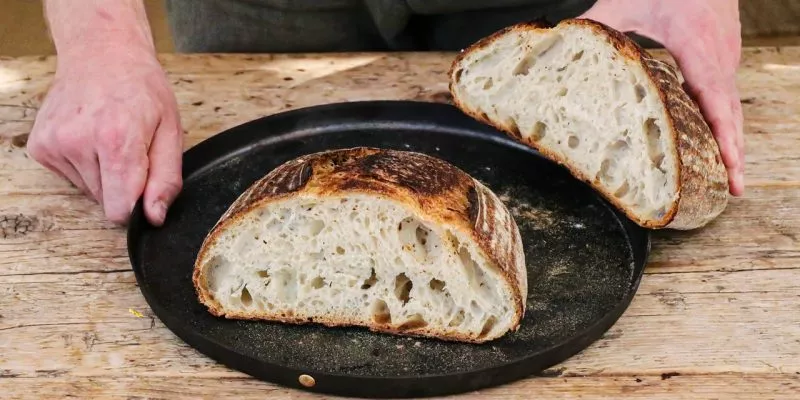Baking sourdough may sound intimidating for beginner bakers. Some recipes can have complex technicalities that can be overwhelming—handling sticky dough, accurately measuring ingredients, and maintaining the starter. But erase that concept with this overnight sourdough recipe.
Overnight sourdough would only take 10 minutes of your effort. Then the rest is a waiting game. Plus, it's the faster alternative. No kneading is needed.
People enjoy using sourdough because there are so many ways to eat it. Some just smear butter on it, and they're satisfied, while some make hearty sandwiches out of it. You can pair it with pasta and soup or crumble it on a salad. You can achieve so many recipes with sourdough.
Sourdough is vegan and vegetarian-friendly. But if you have any medical issues with digesting gluten, you may opt to use gluten-free flour to make your sourdough. Let's begin with the starter.

Sourdough Starter
A sourdough starter is a fermented dough made with flour and water. It contains natural wild yeast and bacteria—lactobacilli—that give sourdough a sour tart flavor. Without a starter, your sourdough won't rise.
The number one rule when making a starter from scratch is patience because it can be unpredictable and would take up to a week before you can start using it. You need to feed it with flour and water regularly.
Once it bubbles and doubles up in size, your starter is ready. Don't over-analyze it. You may succeed on the first try, or you may not. Just keep trying if your goal is to make sourdough at home successfully. If you don't have a starter, you can buy a starter at your local market or ask a friend or a relative if they can give you some.
Sourdough bread is not the only food you can make with a starter. You can make pizza dough, pretzels, pancakes, waffles, and even granola bars.
Now that you know about starters, here is a recipe for overnight sourdough.
Overnight Sourdough Recipe
Ingredients:
50g or 1/4 cup active starter 350g or 1 1/3 cup + 2tbsp warm water 500g or 4 cups + 2tbsp flour 9g or 1 1/2 tsp salt
Equipment:
Large Bowl Fork Bench Scraper Spatula Towel Parchment Paper Cast Iron Pot
Directions:
The Dough:
- Using a fork and a large bowl, whisk together your bubbly starter and water. Add flour and salt, mix until the dough firms up.
- Mix the dough with your hands until all the ingredients are fully incorporated. You will know when done because it will feel dense, and it'll stick between your fingers. Scrape everything as much as your can.
- Leave the dough in the bowl and cover it with a damp towel.
- Let it rest for 30 minutes.
- While you wait for the dough, feed the starter with flour and water.
- After 30 minutes, knead the dough until it's smooth. Use your fingers to fold the outer side of the dough into the middle. Remember to flour your hands before kneading because the dough will stick to your fingers.
- Continue until the dough tightens.
Bulk Rise:
- After kneading, leave the dough in the bowl and cover it again with a damp towel for 8-10 hours at room temperature—allowing it to rise.
- It's ready when it has doubled in size.
Shape:
- Flour your workstation, then carefully take the dough out of the bowl using a spatula.
- With floured hands, work the dough until it's round in shape. Start from the top edge of the dough and fold it in the center. Turn it clockwise or counterclockwise and repeat the process until you form a roundly circular dough.
- Flop it over and let it rest for 5-10 minutes.
Second Rise:
- Line a bowl with a floured towel.
- With a bench scraper or your hands, move the dough in the bowl, seam side up.
- Cover the bowl and let it rest for another 30 minutes.
- While the dough is rising, preheat the oven to 450° F or 230° C.
- Cut parchment paper about the same size as the inside of your cast iron pot. Leave enough excess to make it easier to remove the bread.
Score:
- After 30 minutes of resting, take the towel off the dough and place the parchment paper over the bowl.
- Flip it over to release the dough from the bowl.
- Use the tip of a serrated razor to score the dough with four slashes in a cross-cut pattern.
Baking:
- Then pick up the parchment paper with the dough to place it in the cast iron pot. Cover it with a lid.
- Bake the dough for 30 minutes.
- Remove the lid and bake for another 20 minutes.
- Take the bread out and bake for an added 10 minutes to make the crust crispy.
- When done, allow it to cool for 10 minutes before slicing.
Tips, Tricks, and Helpful Hints
Starter:
- If you store your starter in the fridge, you can feed it every 2-4 days, depending on how often you bake. The more you bake, the more you'd have to feed your starter.
- Feed your starter the night before you plan to make bread.
- If your starter doesn't seem bubbly after feeding, dump a teaspoon full of starter and start the process again to nurse it back.
- It's best to throw your starter away and make a new one if you haven't fed it for over a week. Allow your peers to feed it if you plan to go away for a vacation or a business trip.
- It's best to store your starter in an airtight jar.
- Feed your starter every day at a consistent schedule if you're storing it at room temperature.
Sourdough Bread:
- It's best to schedule baking an overnight sourdough accordingly so you can do other things. Feed your starter the night before you plan to bake to get it bubbly and active.
- To maintain the freshness of sourdough, let it completely cool down before putting it in the freezer because the refrigerator will harden it. Fully cover it in aluminum foil place it in a ziplock bag. Take out all the air as much as possible and seal it tightly. Use a vacuum sealer if applicable.
- To thaw sourdough, allow it to defrost while inside the foil. Once it's thoroughly defrosted, mist it with water and place it in a hot oven for 5 minutes.
- Sourdough's shelf life is about 4-5 days at room temperature, but storing it in the freezer will prolong its lifespan to 2 months if it's stored properly.
Recommended courses on baking sourdough
Here are a couple of courses to learn how to make overnight sourdough bread at home:


